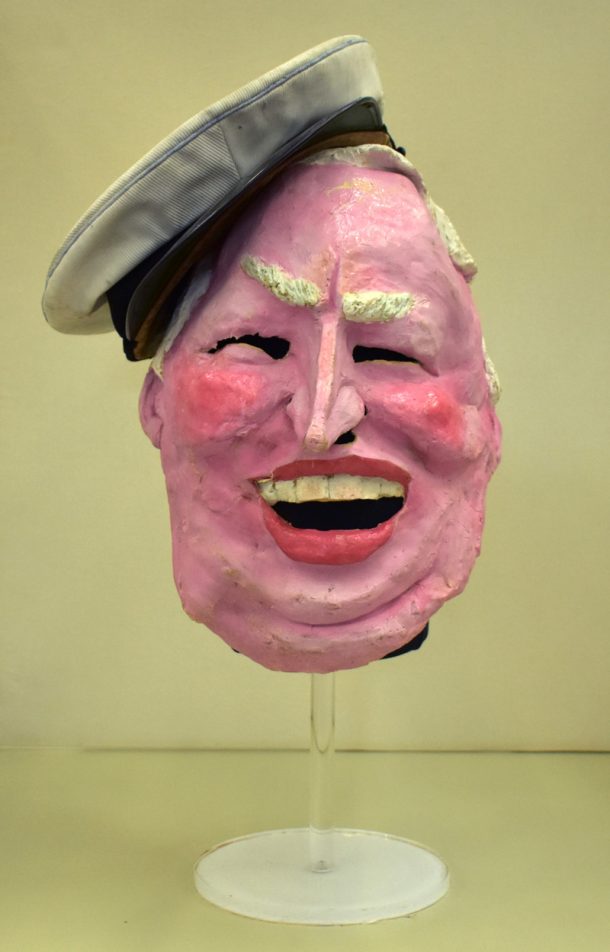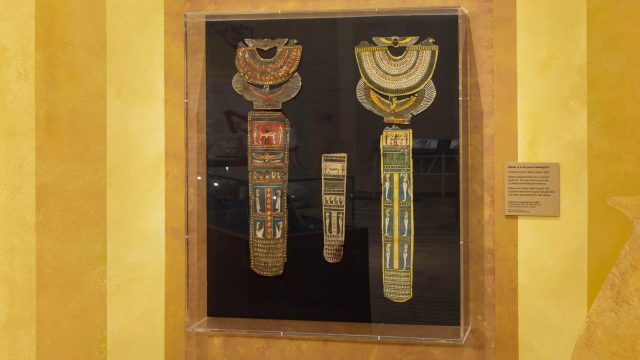by Jacquelyn Peterson-Grace, MS Conservation student, Winterthur/University of Delaware Program in Art Conservation
This full-face latex caricature of Edward Heath was part of the Victoria and Albert Museumu2019s 2018 exhibition Censored! Stage, Screen, Society at 50 that explored the role of censorship in the arts from the seventeenth century to contemporary creations (Figure 1). The theatre mask, originally worn in the 1980 play A Short Sharp Shock, came to the Museum in an archive but was not accessioned due to its inherently unstable materials. Despite its non-accessioned status, the poor condition of the mask necessitated treatment before exhibition, which posed challenges for formulating an approach that would meet the goals of treatment while adhering to ethical standards of conservation. Treating this non-accessioned object provided unique circumstances to explore alternative approaches for stabilization and loss compensation.
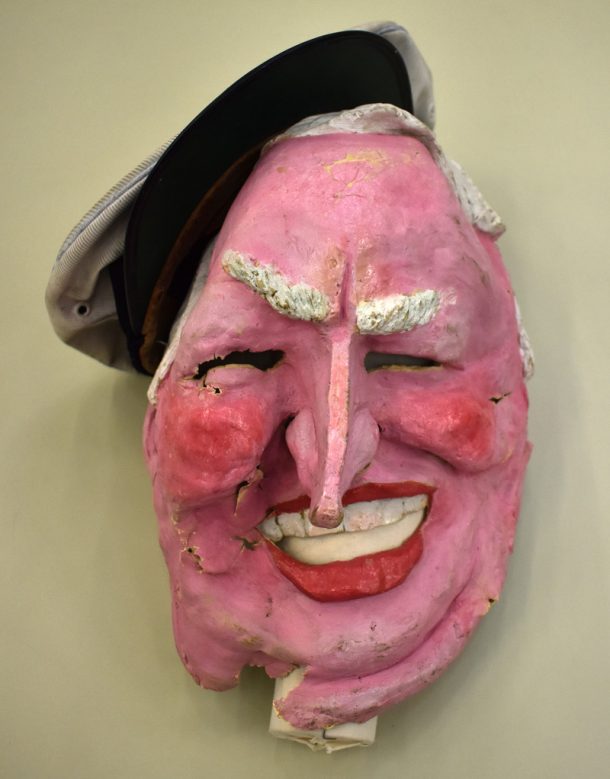
The mask was visually identified as latex by Brenda Keneghan, V&A Senior Polymer Scientist. Latex, a viscous plant sap that hardens to form natural rubber, is particularly susceptible to oxidative degradation that results in embrittlement of the initially flexible material. This inherent instability means that latex objects have a shorter lifespan than other materials, thus presenting interesting parameters for selecting materials to use in treatment. The non-accessioned status of the mask and its instabilities make retreatment unlikely. Consequently, the process of selecting materials for treatment could prioritize working properties rather than long-term stability.
Prior to treatment, the mask was in poor condition. The overall shape was distorted from inadequate storage. Losses in the latex were visually distracting. Though most of the latex retained some flexibility, the edges were embrittled and pieces of painted latex were shed when the mask was handled. The mask also has a distinct rubber smell, and accretions that resembled makeup around the mouth and chin on the interior illustrated its theatre use.u00a0
The mask was to be displayed beside an image from the 1980 theatre production that showed two similar masks being worn (Figure 2). Therefore, the primary goal that informed treatment decisions was improvement of the masku2019s shape and aesthetic appearance. Treatment needed to address structural instability, especially in areas that had already started to harden. Thoughtful mounting was required to reshape and provide support to the deformed latex. Loss compensation was needed to make the areas of missing painted latex less visually distracting.
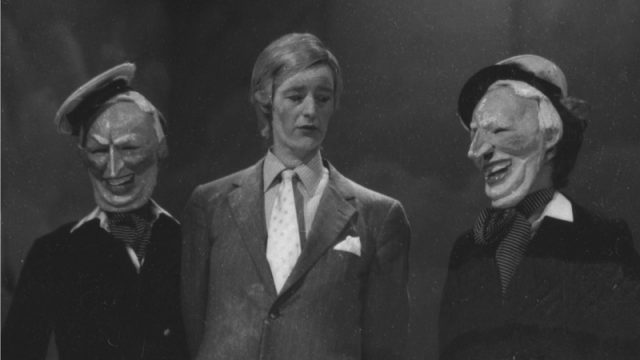
With these goals in mind, experimentation was begun to determine the best methods and materials for treatment.u00a0 Local patches applied to the interior of the mask would provide structural stability while limiting the visibility of the treatment. Medium-weight non-woven polyester Reemay was selected as the backing, as it offers strong dimensional support and was able to conform to the irregular surface of the mask. Beva 371 film was chosen as the adhesive for its ability to be heat-reactivated, thus avoiding the use of water or solvent on the sensitive latex surface, and for its strength, as the support patches would be required to flex as the mask was placed onto its display mount. The patches extended well beyond the areas of loss to provide structural support to the degrading latex (Figure 3).
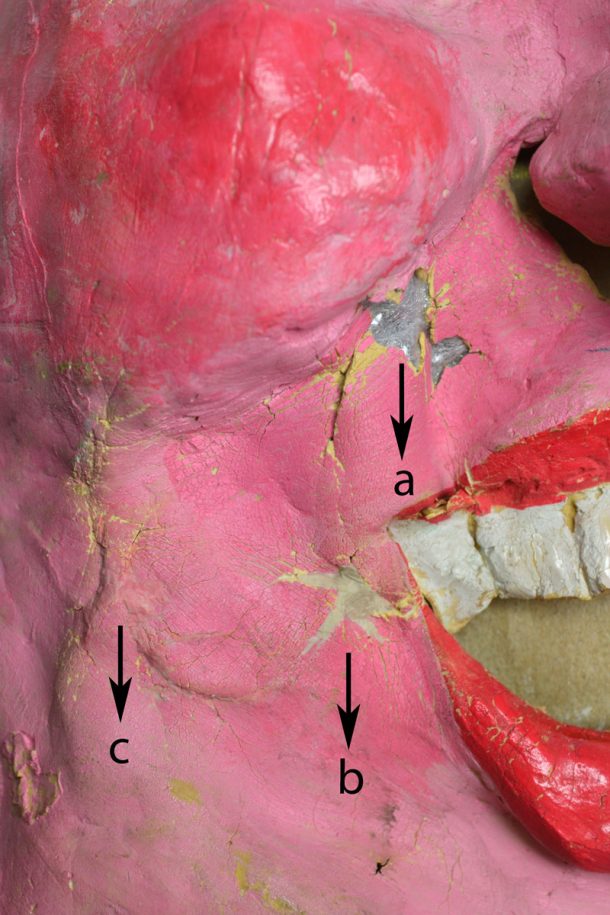
Once structural stabilization was addressed, options for loss compensation were considered and a variety of fill materials were tested. The fill material needed to be opaque and mouldable to mimic the texture of the surrounding latex, to remain flexible as the fills would inevitably flex as the mask was taken on and off its mount, and to accept paint, so the fills could be toned. Of all the materials tested, Newplast Plasticine modelling clay gave the best results. The clay, a blend of calcium salts, petroleum products, fats, and pigments, is non-drying, easily sculpted to impart surface texture, and retains its shape and flexibility over time. The losses, backed with Reemay, were filled with grey Plasticine clay that was sculpted to match the surrounding surface texture.
The matte surface of the mask dictated that the fills be toned with a matte inpainting medium, necessitating a multi-step inpainting process. Only acrylic paints would adhere to the waxy surface of the clay, so the fills were primed with acrylic matte medium before being toned with gouache paint mixed with fumed silica. The fumed silica further matted the paint to blend well with the surrounding painted latex.
A custom head-shaped mount was created from buckram (linen and wheat starch paste), covered with polyester wadding and black cotton jersey fabric. Additional padding was added as needed to provide support and restore shape to the distorted mask.
The treatment protocol successfully met the goals of structural stabilization and visual reintegration of losses, and the custom mount offers support to hold the mask in a shape similar to its original configuration (Figure 4). However, the materials used in the treatment pose degradation concerns of their own. Information provided by the manufacturer states that Plasticine can stiffen upon aging, and anecdotal information suggests that calcium salts may leach out. The fill material that best suited the aesthetic needs of the treatment does not have stable aging properties, which violates an important tenant of conservation treatment. However, the latex itself will continue to degrade and stiffen, and the mask was not to be accessioned due to its inherently unstable composition. These parameters make retreatment highly unlikely. The treatment, though invasive, has resulted in much greater structural stability for the mask. It is unlikely that additional latex will be shed from the edges of existing losses, and as the latex continues to oxidize and harden it will retain its original shape thanks to the custom mount. The ageing properties of the Plasticine are questionable, but the fills will likely remain stable for the duration of the lifetime of the latex.
This treatment provided the opportunity to develop a protocol for addressing structural instabilities and visually distracting losses in flexible rubber-based objects. The protocol may be used on other objects, and avenues for future research include identifying a fill material with more stable ageing properties for future treatments.
u00a0
